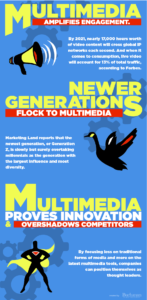– Alex Harris
It’s no secret – we’ve all watched a Tasty video, completed a BuzzFeed quiz and tuned in to a Facebook live video. When comparing today’s digital landscape with the dawn of the internet and even the start of social media platforms, there are few similarities. As technology continues to change more and more quickly, analyzing multimedia trends has become essential to successful communication strategies.

For starters, less obvious social media platforms are reeling in consumers. We know that Facebook has more than 1 billion daily users. However, it may surprise you that, during primetime TV hours, adults consume more online video content via mobile devices than through traditional TV networks, according to Google. Pinterest is another social media mecca that is often overlooked. This Hootsuite article reveals that Pinterest is the third largest social media platform by active user count. Approximately two thirds of all pins are brand-related, and 93% of Pinterest users use the platform to plan purchases. These trends become even more extreme when narrowing in on millennials and Generation Z.
The purpose of social media is to spread content for one reason or another, which is why it may be a business’ best friend. For context, some less obvious multimedia tools include everything from interactive website banners and infographics, to polls and surveys, to name a few. Employing these multimedia strategies takes social media, and digital presence in general, to the next level. Here are three important reasons why:
1. Multimedia amplifies engagement. Countless studies show that social media posts with images outshine text-only posts. Similarly, videos on Facebook rank above photos on the engagement scale, at three times more engaging than plain text. By 2021, nearly 17,000 hours worth of video content will cross global IP networks each second. And when it comes to consumption, live video will account for 13% of total traffic, according to Forbes. Podcast Insights reveals that in the U.S., 44% (124 million) of the U.S. population listens to podcasts monthly, up from 40% last year. Although there is little research on how the most innovative forms of multimedia impact engagement, the sheer interest in these new tools almost speaks for itself.
2. Newer generations flock to multimedia. The newest generation thrives on the latest and greatest technologies. Marketing Land reports that the newest generation, or Generation Z, is slowly but surely overtaking millennials as the generation with the largest influence and most diversity. At 26% of the current population, they represent 48% of the total media audience. No matter a company’s audience, this generation is critical.
3. Multimedia proves innovation and overshadows competitors. All companies benefit by being seen as innovators. Industry-leading reputations are often key to standing out among competitors when it comes time to pitch your business to a potential client. By focusing less on traditional forms of media and more on the latest multimedia tools, companies can position themselves as thought leaders.
The fact that the media landscape is changing is unsurprising. However, how people are engaging with businesses begs more notice, especially when it comes to employing new strategies.